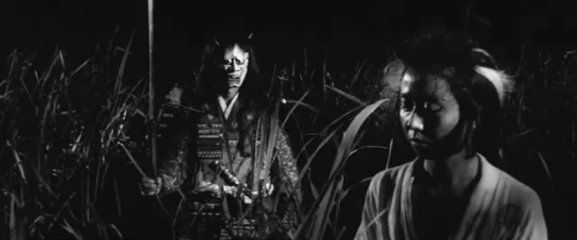A vast field of grass. There's no telling what demons and snakes live here.

There may be no ghosts or goblins in 1964's Onibaba, but even without any supernatural trappings it still manages to be one of the most shudder-inducing stories in Criterion's stable. Written and directed by Kaneto Shindô, who also handled art direction duties, it effortlessly captures the feel of a tale passed down through the centuries, which makes sense since it was based on a Buddhist fable. Set during a time of strife, it tells of two desperate women (Nobuko Otowa and her daughter-in-law, Jitsuko Yoshimura) who survive by murdering unwary samurai and trading their armor and weapons for food. They're eagerly anticipating the return of Yoshimura's husband, but when a neighbor (Kei Sato) who was conscripted alongside him arrives at their door bearing bad tidings and shows an interest in taking his place, the stage is set for a psychosexual tug-of-war.
Much as he had done in The Naked Island, Shindô takes pains in the opening sequence to depict the hardscrabble nature of their existence, documenting every arduous step as Otowa and Yoshimura wordlessly kill two samurai, strip them, drag them to a deep pit and unceremoniously drop them in, only to be cheated by the penny-pinching armor dealer they sell their wares to (Taiji Tonoyama). When Sato joins them later on (and manages to get a better deal out of Tonoyama) it seems like it could be the start of a new partnership, but Otowa tries to keep him at a distance, which only helps drive Yoshimura into his arms. Similarly driven by sexual frustration, Otowa offer her body to Sato and is rebuffed, after which she tries some scare tactics, telling Yoshimura stories about the punishments that await sinners in the afterlife. As if on cue, Otowa is then startled by the appearance of a samurai in a demon mask (Jukichi Uno) who provides her with the perfect way to keep her daughter-in-law in line.
Visually stunning from start to finish, Onibaba is highlighted by dramatic lighting and dynamic compositions, with an editing rhythm tied to the undulations of the tall grass as it sways in the breeze. There's also a lot more casual nudity than one might expect from a film made in 1964, but as with a lot of things the Japanese were way ahead of the pack in that area. There's no getting around the ending, though, which is about as bleak as they come. And who knows? Maybe there is a little divine retribution going on as well -- or at the very least some poetic justice.